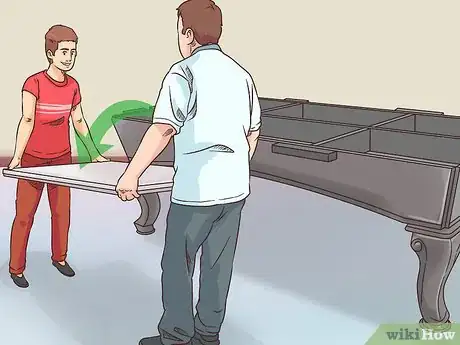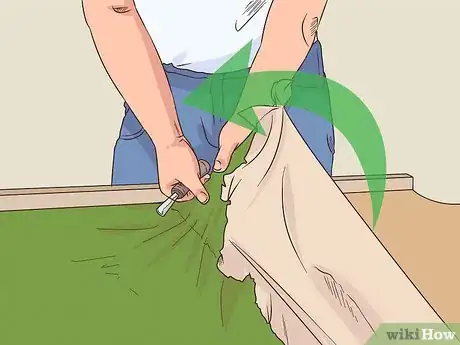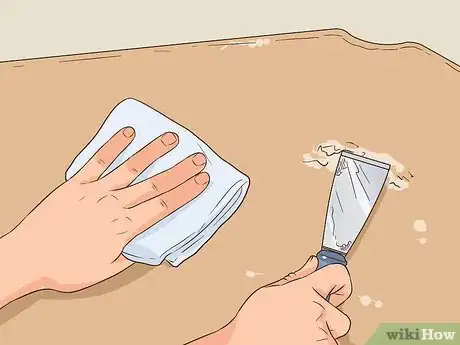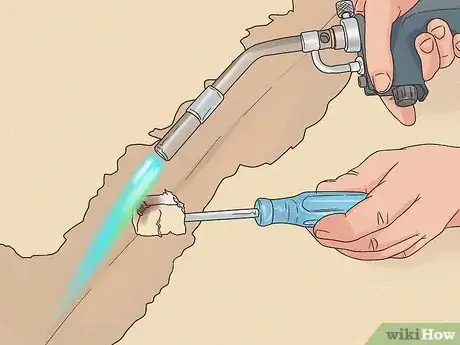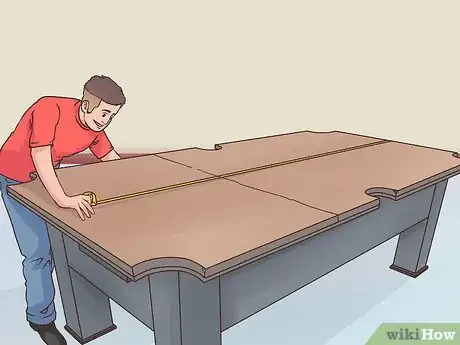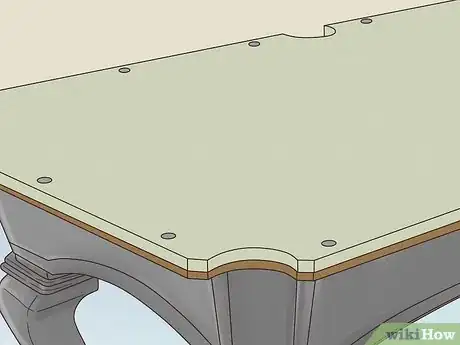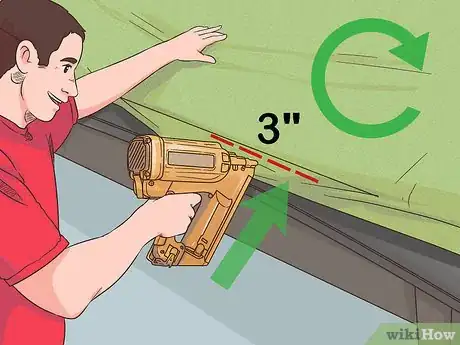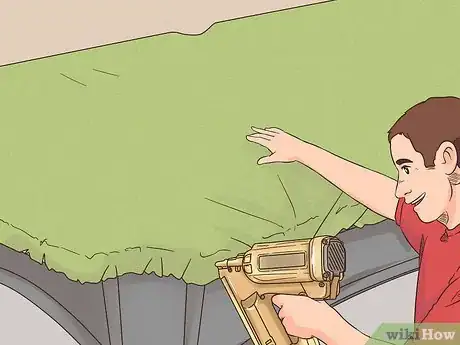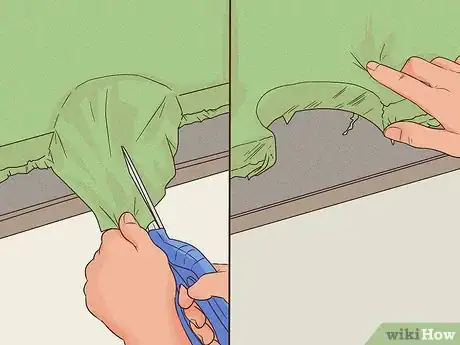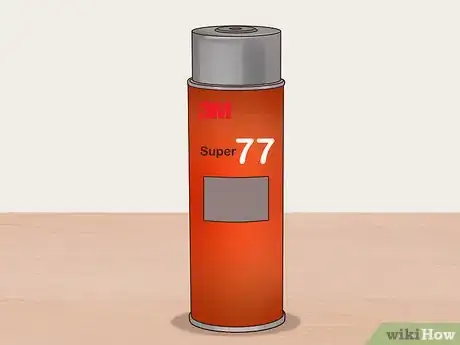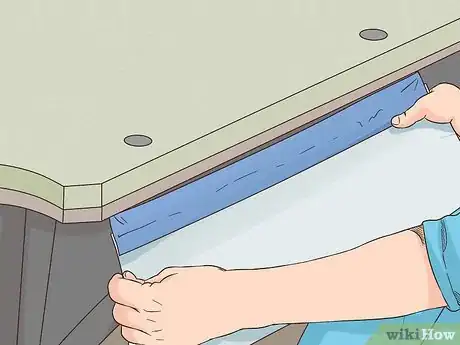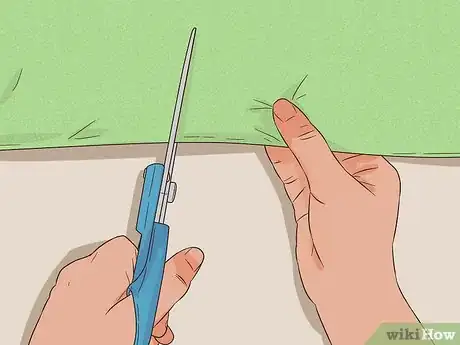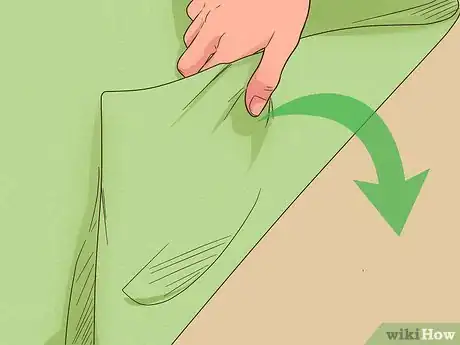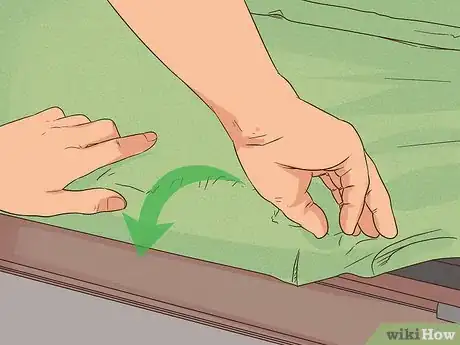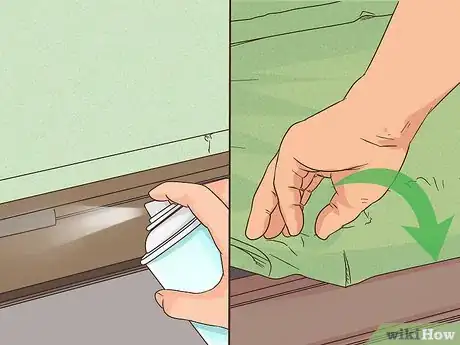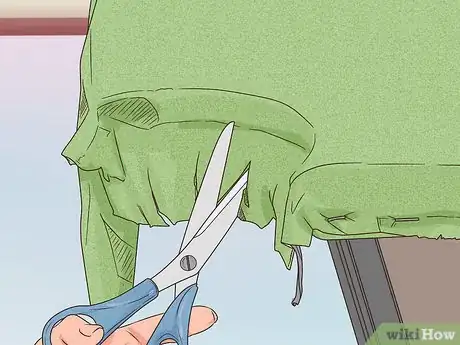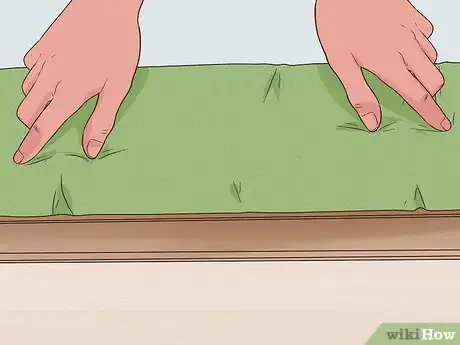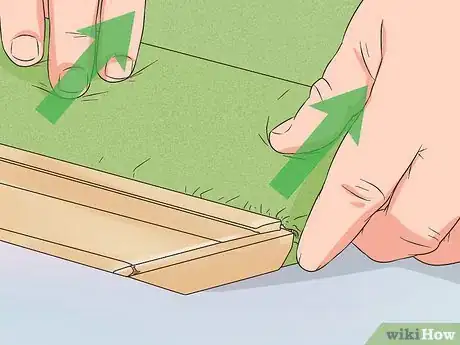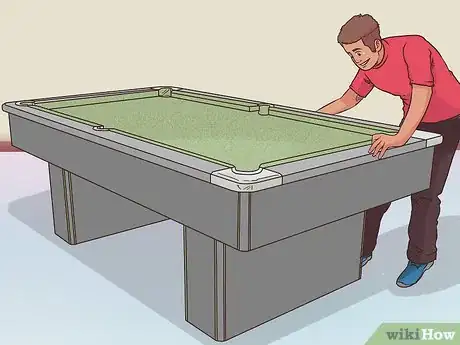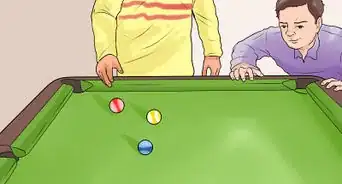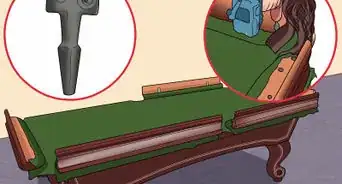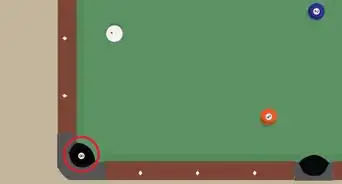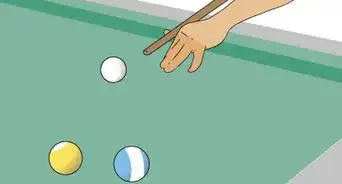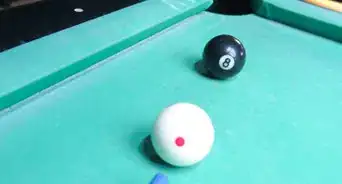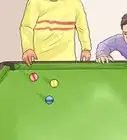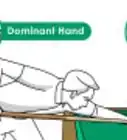wikiHow is a “wiki,” similar to Wikipedia, which means that many of our articles are co-written by multiple authors. To create this article, 13 people, some anonymous, worked to edit and improve it over time.
wikiHow marks an article as reader-approved once it receives enough positive feedback. In this case, 92% of readers who voted found the article helpful, earning it our reader-approved status.
This article has been viewed 382,188 times.
Learn more...
Replacing the felt, or more accurately the pool tablecloth, is often left to professionals, but the tools used are not expensive or complicated. The reason some consider it difficult is the exacting requirements of a pool table. A stretch in the wrong direction, or a little dust left on the table can make your final playing surface bumpy or unpredictable. You can minimize the chance of this happening by working slowly and carefully, and finding an assistant to stretch the cloth as you fasten it.
Steps
Preparing the Table and Felt
-
1Begin disassembling the pool table. Remove the pocket liners from each pocket first, if any are present. Next, find the bolts on the underside of the table keeping the railings in place, and remove them. Move the railing carefully to a safe storage space where it won't get scuffed or damaged, or interfere with your movement around the pool table.
- The railing may be composed of one, two, or four pieces. If the railing does not divide into four pieces, you will likely need an assistant to transport it safely.
- Some pool table pockets are bolted or screwed on separately from the railings.
-
2Remove the old felt. Felt can be attached in more than one way. Use a staple remover if the felt is stapled to the table. If it is glued, you can simply rip the felt off, but be careful not to damage any felt in the pockets unless you also plan on replacing those portions as well.Advertisement
-
3Level the table (optional). You may wish to use a level to test whether your billiards table is flat. If it is not, use a small pry bar to lift the lowest leg and add a wooden or metal shim.
-
4Clean the slate. Use a dry, clean cloth to remove dust. Do not use any water or cleaning solutions. If old glue or other residue has built up, scrape this off with a putty knife or other flat blade, especially where it may block pockets.
-
5Seal the seams with beeswax if necessary. Most pool tables are constructed from three pieces of slate. On an old pool table, the seams between these may have lost some of the wax that fills them in to create a flat surface. If the wax needs replenishing, heat the slate around the seams with a propane hand torch, then drip wax into these seams. Spread the wax evenly across the seam line, let it cool for no more than thirty seconds, then scrape excess wax down to the level of the table surface using a paint scraper.[1] It's better to remove too much wax than too little, since excess wax can be difficult to remove once dry.
- If your pool table is kept in a warm location, you may wish to use putty specifically formulated for pool tables. There is a great deal of disagreement over which of these synthetic products produces the best quality table, so you may wish to consult a local expert familiar with your climate.
-
6Measure your pool table before purchasing felt. Measuring will take the guesswork out of sizing your felt, resulting in a faster process and a cleaner result. When you purchase the felt, or more technically the pool tablecloth, for your table, make sure it is at least 12 inches (30.5 cm) longer than the table on all four sides. This ensures that you will have plenty of cloth for the railings as well as the table surface.
- Note that pool felt is actually a special type of cloth, and while it is commonly referred to as "felt," it is usually sold as "pool tablecloth," "pool cloth," or "billiards cloth." You cannot use ordinary felt to cover your pool table.
- Woolen pool cloth is the pool felt most players are familiar with. Worsted cloth allows for greater speed, but is rarely used outside of professional tournaments due to its lessened durability and price. Other varieties such as snooker cloth, carom, or polyester cloth are only suitable for certain uses.[2]
Stapling the Felt Playing Surface
-
1Use this method if there is a wooden or particle board backing. Many tables have a wooden or particle board layer beneath the slate, allowing staples to be attached. You can check whether this is true of your table by examining the perimeter or vertical edge of your table. If there is only slate, use the instructions for gluing the felt instead.
- Note: You will need a "hammer tacker" or manual stapler, or a staple gun.
-
2Cut the felt into pieces for the table and railing. Typically, the felt comes in one large piece, and includes instructions for removing pieces to fit each railing. Follow these instructions carefully, or the cut pieces may not fit your table.
- With some felt, you can make a one inch (2.5 cm) cut, then rip the felt by hand in a straight line.[3] Other felt may require cutting with a razor blade or box cutter.
-
3Roll the felt out face up over table. Look for a sticker or other label that tells you which side is face up. If it is unlabeled, and you cannot easily tell which side is the playing surface, consult a professional. Different types of felt have a different feel, so it's best not to guess if you are not familiar with the feel of that type.
- Hang more of the extra felt over the foot end, and not much on the head end where you will begin installation.
- Check now for rips, scratches, or other defects that could require you to get a refund or replacement.
-
4Stretch the felt across the head end and staple it on the vertical edge in several places. Use your hammer tacker or staple gun to attach the felt to the wooden or particle board lining of the table at one corner of the head end. Have an assistant help you stretch the felt across the head end until there are no wrinkles present, keeping the overhang parallel with the table edge. Staple about every 3 inches (7.5 cm) along this stretched edge, ending at the second corner.
- Professionals play on a very tightly stretched surface, which allows for greater speed. This is not necessarily desirable for most players, however, who may enjoy playing on a slower table. Always stretch at least tightly enough to remove all wrinkles, however.
-
5Repeat the process on the left side. Move to one of the long sides of the table, and have an assistant help you pull the felt taut along its length. Staple at roughly 3 inch (7.5 cm) increments, but make sure to staple on either side of the side pocket.
- Pulling the felt over each pocket when stapling on either side will give you extra material to work with when lining the pockets.
-
6Staple on the foot end, then the right side. Pull the felt tight from the last unstapled corner. Pay special attention to this, as an inconsistent pull can cause wrinkles in your table. If the previous staples make it impossible to create a flat surface with this pull, with the overhang parallel with the table end, you may need to remove a couple staples with a staple puller and try again. Once this is pulled to a smooth surface with the desired tightness, staple the short foot end and remaining right sides along their lengths.[4] [5]
- Remember to staple on each side of the side pocket.
-
7Trim the material at the pockets and staple it inside. Make three slits in the felt directly over each pocket, then fold the loose felt down into the pocket and staple it inside the pocket. Once this is done, use a pair of scissors or a razor blade to snip off the excess felt.
Gluing the Felt Playing Surface
-
1Use specialized spray adhesive if the table cannot be stapled. If your table has no wooden or particle board backing underneath the slate surface, you'll need to find a specialized adhesive to glue the felt to the slate instead. If you do see that backing, follow the instructions for stapling the felt instead.
- 3M Super 77 Multipurpose Adhesive is a popular option.
-
2Cover the sides of the table with newspaper. Protect the edges of the table from spilled glue with a layer of newspaper, overhanging the edge. Remove newspaper from each edge just before you lower the glued felt.
-
3Cut the felt according to the manufacturer's instructions. Felt usually comes in one large pieces, along with instructions for cutting off strips for each railing. Follow these instructions to ensure you end up with pieces of the correct size.
-
4Identify the playing surface and place the felt over the table. If the "face up" surface is not labeled, try to identify it by feel or consult a professional. Your felt playing surface may be smooth, or it may have a "nap" in one direction, depending on the type; you may need to have an expert identify the face-up side if you are not familiar with the material. Arrange the felt over the table, leaving only a couple inches (a few centimeters) of overhand on the short head end. Make sure each overhang is as parallel to the table edge as possible.
-
5Fold the head end of the felt up and apply glue. Fold the head end of the felt over onto the table, exposing the underside that will hang over the vertical side of the slate. Spray that portion of the underside heavily with the adhesive, and spray the slate where it will be attached as well. Let this sit until it becomes tacky, according to the adhesive manufacturer's instructions.
-
6Carefully attach the felt to the table. Starting at one end, align the glued felt carefully with the slate, press down, then move along the glued end, pulling tightly as you attach it to the table. You may need an assistant to ensure the material is taut, especially at the beginning of the process.
- The felt should be tight enough to prevent all wrinkles, but an ultra-tight surface is not necessary unless you want to practice for professional tournaments. Most importantly, you should pull the felt with the same pressure throughout this installation.
-
7Repeat the process with the far end and the long sides. The gluing process is identical for each of the remaining three sides. Wait at least a couple minutes between each side, or however long the adhesive manufacturer recommends to create a strong initial bond. Carefully pull each side taut before you apply glue, making sure there are no wrinkles on the cloth and you are pulling with the same force on every side.
-
8Trim the felt, and use the excess to line the pockets. Trim the excess felt overhang on each side. One one side, cut a one inch (2.5 cm) wide strip of material for use as pocket liner. Cut off the material stretched over the pockets, then cut this strip into smaller pieces, gluing them over the vertical, circular surface of the slate to protect it from the pool balls.
Replacing the Railing Felt
-
1Remove old felt from rails. Use a staple puller or flathead screwdriver to remove the staples from the ends of the rails. Cut the old felt along the top of the rail if it does not come off immediately.
-
2Gently remove the wooden feather strip. Each rail has a thin wooden "featherstrip" running alongside it, which is typically not attached by any adhesive or nails. If it won't come up easily, Use a thin flathead screwdriver to pry it up without breaking it.
-
3Place a new strip of felt over the rail. Unlike the table top, this felt should be "face side" down. Keep an overhang of at least 4 inches (10 cm) on each end, and 1/2 inch (1.25 cm) over the feather strip groove.[6]
-
4Use a tapping block and hammer to wedge in the center of the featherstrip. Lay the featherstrip back in position, but do not press it down. Have an assistant stretch the felt tightly between the center and one end of the railing. Place a tapping block over the featherstrip, then use a hammer to gently tap the block, pushing the featherstrip down into the stretched portion of the felt, but stop about 2 inches (5 cm) from the end, where the corner pocket will be located. Stretch the other half of the felt, and repeat this process for the remaining length of the featherstrip, again stopping 2 inches (5 cm) away from the other end.
- Do not strike the featherstrip directly, or you may dent the table.
-
5Pull felt toward the cushion and tap in the ends of featherstrip. Pull the felt at the ends of the table toward the rubber cushion, then tap in the remaining portion of the featherstrip until it is firmly in place. Trim and fold the felt as necessary to remove excess material and cover the ends of the cushion.
-
6Reassemble the outer rails. Once all your rails are complete, bolt them to the table again. If you're having a hard time finding where the bolts should go, you can push a screwdriver through the bolt holes as guidance. Never try to cut holes in the playing surface from the top of the table, as you may cut in the wrong place.
Community Q&A
-
QuestionIs the right hand side of the table considered from the breaking end?
 Community AnswerYes, always from the baulk (breaking) end. The action end is where the balls are stacked, and the right and left are, obviously, right and left.
Community AnswerYes, always from the baulk (breaking) end. The action end is where the balls are stacked, and the right and left are, obviously, right and left. -
QuestionI just want to tighten up my felt - can I use my old felt if it is not damaged?
 Community AnswerI have reused felt up to four times. Yes, it can be restretched. But keep in mind, each time you stretch it, you are degrading it somewhat. At some point the fibers will pull apart.
Community AnswerI have reused felt up to four times. Yes, it can be restretched. But keep in mind, each time you stretch it, you are degrading it somewhat. At some point the fibers will pull apart. -
QuestionDoes it matter which side of the slate on a one piece slate valley table is facing up?
 Community AnswerThe flattest, longest side of the slate should always be pointing up. Many have tried (and failed) to install slates on their side, but this results in an awful game of pool.
Community AnswerThe flattest, longest side of the slate should always be pointing up. Many have tried (and failed) to install slates on their side, but this results in an awful game of pool.
Things You'll Need
- New pool tablecloth
- Hammer tacker or staple gun
- or Special adhesive (such as 3M Super 77)
- Flathead screwdriver
References
- ↑ http://www.bestbilliards.com/resources/recover/preppingslate.cfm
- ↑ http://www.cuesight.com/types-of-pool-table-felt.html
- ↑ http://www.cuesight.com/howtoinpotaf.html
- ↑ http://www.cuesight.com/howtoinpotaf.html
- ↑ http://www.bestbilliards.com/resources/recover/coveringslate.cfm
- ↑ http://www.cuesight.com/howtoinpotaf.html
- Videos provided by BlueWaveProducts
About This Article
To felt a pool table, start by disassembling the pool table and removing the old felt. Once the old felt is off, use a dry, clean cloth to remove any dust, and a putty knife or a flat blade to scrape off any old glue or residue build up. Next, measure your pool table and add at least 12 inches to all 4 sides to ensure you’ll have enough cloth for the railings as well as the table surface. Then, roll the felt out face up over the table and, if there is a wooden or particle board backing on your table, staple it along the edge of the table every 3 inches. To learn how to glue the felt onto your pool table, keep reading!
